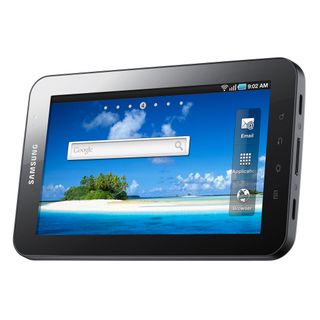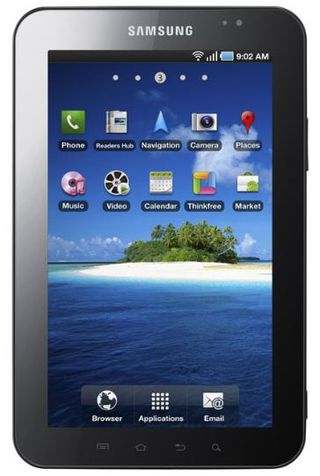Apple Vs. Everyone Else: The Top 4 iPad Alternatives
Apple's iPad appears to be winning the tablet war for 2010 or 2011, but we want to keep you up to date on the stiffest competitors coming down the pipeline.
Galaxy Tab (Samsung)

The Galaxy Tab from Samsung is probably the highest-profile Android tablet in the pipeline right now. An impressive hardware list gives the device plenty of horsepower, while Samsungs relationships with all four major American cellular carriers means distribution will be a snap.
| Samsung Galaxy Tab | |
|---|---|
| Operating System | Android 2.2 w/ TouchWiz 3.0 UI |
| Display Size, Reolution | 7", 1024x600 |
| CPU | 1 GHz Cortex A8 |
| GPU | PowerVR SGX 540 |
| RAM | 512 MB |
| Onboard Storage | 16 GB or 32 GB |
| Touchscreen | Capacitive |
| Camera(s) | 1.3 MP front, 3 MP back |
| Ports/Expansion | 30-pin connector, microSD |
| Connectivity | WiFi, Bluetooth, 3G |
| Availability | Q4 2010, Multiple US Carriers |
From a hardware standpoint, the Galaxy Tab sounds like a high-end Android smartphone (screen size aside). The 1 GHz Cortex A8 CPU, PowerVR SGX 540 graphics, 512 MB of RAM and 16 GB of storage (there will be a 32 GB version as well) keeps the Galaxy Tab in line with Samsung’s Galaxy S line of Android-based smartphones.

The Galaxy Tab also packs two cameras, with a 1.3 megapixel sensor in front for video chat, and a 3 megapixel sensor on the back for taking video and pictures. It’s not as fancy as the PlayBook, but two cameras are better than none (we’re looking at you, iPad). Like the PlayBook, the Galaxy Tab can handle 1080p video, but the tablet will need either a dock or a proprietary-to-HDMI cable in order to pump video out to an HDTV. While expansion on the PlayBook is TBA , Samsung has equipped the Galaxy Tab with microSD, allowing for up to 32 GB of extra storage.
Much like its smaller brothers, the Tab will run Android 2.2 with Samsung’s TouchWiz 3.0 UI on top. Purists and power users will likely scoff at the included UI, but we’re still dealing with Android here. As for apps, Samsung has crafted a few of its own for the device, including video chat, email, messaging, among others. Beyond that, you’re traveling to the Android Marketplace. The Galaxy Tab also has support for Flash 10.1.
Samsung has adopted a very appealing strategy for its newest Galaxy S smartphones by releasing variants on all four major American cellular carriers (Epic 4G on Sprint, Fascinate on Verizon, Captivate on AT&T and Vibrant on T-Mobile). From the looks of it, Samsung will be deploying the Galaxy Tab in the same fashion, although the differences for each carrier will likely be less obvious than with the smartphone line (Sprint getting a QWERTY keyboard, Verizon getting stuck with Bing, etc). All four carriers will be getting a WiFi/3G-friendly Galaxy Tab, and it’s also been confirmed that Sprint’s version will not be 4G.
So the Galaxy Tab does share some traits with the iPad, especially in the CPU and GPU department. When it comes to software, we are looking at a matchup similar to the iPhone and Galaxy smartphones. Android 2.2 has been very well-received, but many are still on the fence regarding the Android Marketplace. There are going to be dozens of Android-based tablets in the coming months, but the Galaxy Tab is in the best position because of Samsung’s deployment strategy, solid hardware specs and the included custom apps.
Sign up to get the BEST of Tom’s Guide direct to your inbox.
Upgrade your life with a daily dose of the biggest tech news, lifestyle hacks and our curated analysis. Be the first to know about cutting-edge gadgets and the hottest deals.
Current page: Galaxy Tab (Samsung)
Prev Page BlackBerry PlayBook (Research In Motion) Next Page Slate/PalmPad (HP, Palm)Devin Connors currently works as a community manager for Rocket League at Psyonix Studios, but he was previously a senior editor at Tom's Guide, writing about gaming, phones, and pretty much every other tech category. His work has also appeared in publications including Shacknews, GameZone, The Escapist, Machinima, and more.
-
dconnors sliemWhat about the (estimated) prices?How about Archos tablets?Reply
Pricing for a few of these tablets is still not available...but honestly, the price range is going to be the same range as the iPad.
ARCHOS is making some great tablets, but the company and their products lack the clout that Microsoft, HP, and Samsung bring to the table.
-Devin -
Luscious HP will have a hard time marketing an already-obsolete Atom platform to the educated consumer and enthusiast. I'm hoping they actually go with an N550 or better, but that Broadcom solution has already been proven to be too driver dependent for reliable playback across multiple HD codecs. AMD's Nile platform is much more elegant and works far better, but it would be a tough job squeezing Nile into a sub-10" form-factor. I like Windows 7, especially when it comes to media streaming and remote connect, but not on a puny Z530.Reply -
Archos has been around doing these types of devices for a while now. And though i've never owned one, their current lineup looks pretty decent. Maybe it's time you guys started giving them a little respect and included them in these types of lineups.Reply
-
I own an iPad and the one thing that makes the device much more useful than 99% of the devices I have ever owned is its battery life. All the bells and whistles are worthless on a mobile device if you lose power. None of these reviews mention anything about battery life.Reply
-
What about the Blackberry PlayBook's battery life? Huh?Reply
It uses a faster CPU with more RAM and a faster GPU. It is sure to eat up battery life.
If it doesn't last 12 hours a charge like the iPad does, then it is going to fail. -
cknobman I hate apple and will never own one of their products.Reply
That being said I think its stupid to have an "iPad alternatives" article covering a bunch of products that technically don't exist (at least to the consumer). All that is covered here is a bunch of pre release and prototypes which means little to nothing for someone actually looking for an iPad alternative today. -
back_by_demand How about just bringing them to the market, letting us buy them, use them and then write our own reviews on them.Reply -
These four can not be seen as alternatives, since not a single one of them is for sale. The title is misleading at best. Should have been "Future iPad Alternatives". It is not even guaranteed that any of these devices will survive long enough to hit the market at all.Reply
So what are the "The Top iPad Alternatives AVAILABLE TODAY"? -
farrow099 I waited months hoping SOMEONE would actually bring a legit android tablet to market. They have all been vaporware.Reply
The only android tablet expected to actually hit the market this year is the samsung galaxy tab. And I don't think that is an accident as samsung seems to produce most of the ipad components as well.
If anyone is wondering; I own an EVO 4G phone, an iPad, and a win7 x64 desktop.
